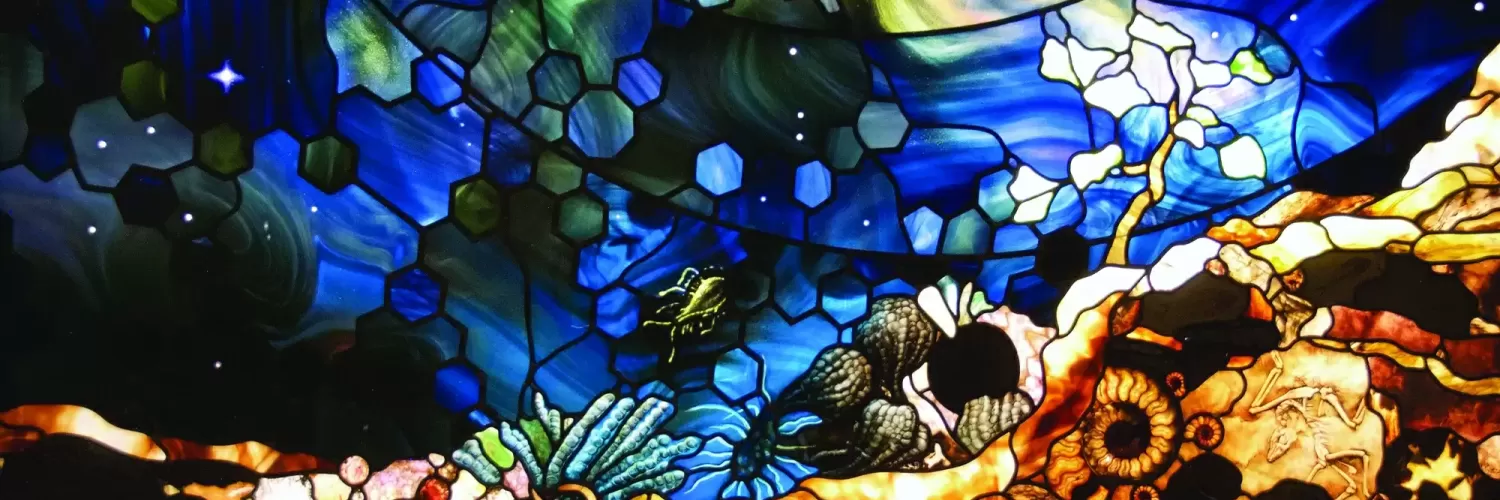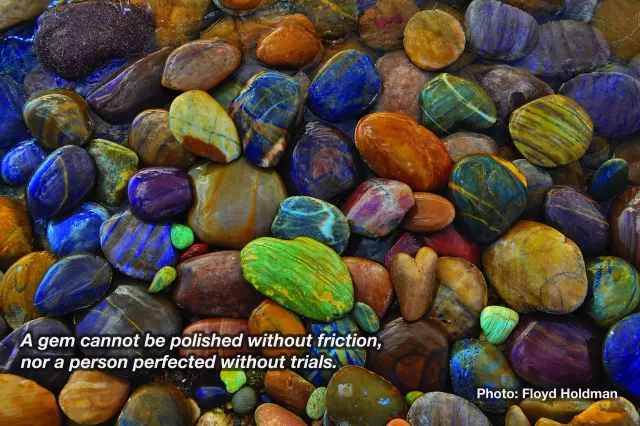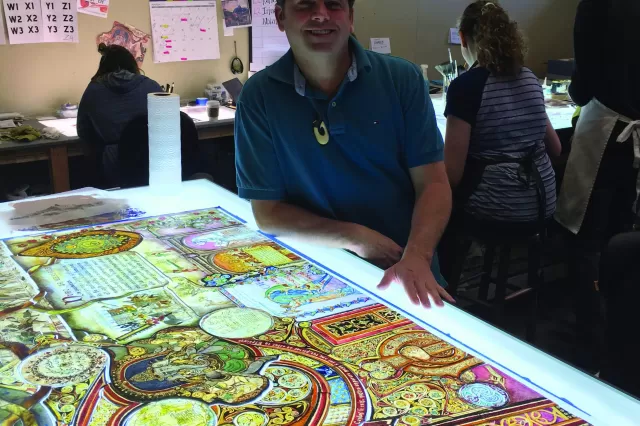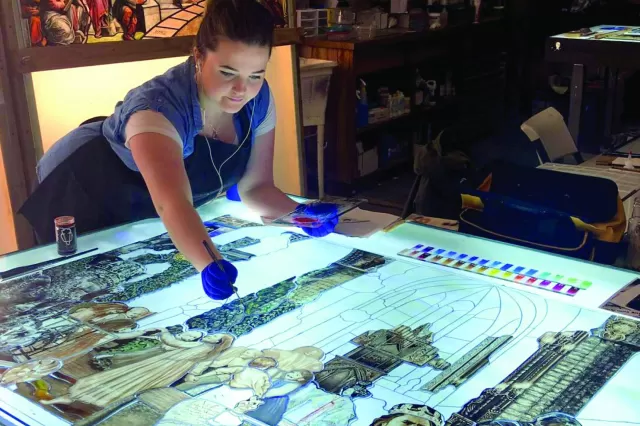Excerpt from Stained Glass Spring 2016 - Vol. 111, No. 1
By Amie Jane Leavitt
Like many stained glass artisans Tom Holdman started his career in his parents’ garage. He has excelled in glass on the wisdom his father shared with him growing up.
Rocks. Painted rocks.
It’s hard to imagine that something so spectacularly beautiful as a stained glass window could trace its beginnings back to a pile of painted rocks. But this is exactly the case for every single stained glass window created by Holdman Studios. After all, if it hadn’t been for an experience Tom Holdman had with a selection of rudimentary painted rocks from his childhood, he may have never pursued a career in the arts at all. As a result, Holdman Studios and the stained glass windows created there would have never existed.
Tom explained this pivotal experience in his life. “When I was seven years old, I showed my dad some rocks I had painted. They probably weren’t even that great, this being my early attempts at art. But my dad made a huge deal about them. He told me they were so good that he would include them in
one of his photographs.” Tom’s father, Floyd Holdman, was a freelance photographer whose work was regularly featured in National Geographic and other publications. “Here I was seven years old and my dad, this famous photographer, wanted to include my artwork in one of his photos,” Tom explained. “That moment was huge for me.” It was at that instant that Tom really started to believe that he could be a success in whatever he wanted to pursue in his life, including being an artist. “I didn’t think, ‘Hey, I can be an artist one day.’ I thought, ‘Hey, I already am an artist!’”
Memories like this are on Tom’s mind lately, especially since his father recently passed away after a six-year fight with cancer. Floyd’s influence in Tom’s life and career has been paramount, making Tom the person he is today. “None of this would have been possible if it hadn’t been for the encouragement that I received from my dad throughout my life,” Tom stated. “He was always one of my biggest supporters.”
Floyd Holdman loved uplifting quotes and would often shower them on his family, especially his children. Because of that, some of Floyd’s favorite quotes were used as the catalyst for this article. They illustrate the inspiration behind Tom’s journey from a young seven-year-old rock painter to an internationally renowned stained glass artist.
“Following your dreams is no guarantee of an easy ride.”
Tom is no a stranger to the tough road. He was born with a severe speech impediment and because of that, he has struggled to communicate throughout his entire life. “At one point,” Tom explained, “things were so difficult for me as a child, and I was so frustrated with trying to talk to people, that I actually considered learning sign language and pretending that I was deaf so I wouldn’t have to talk anymore.” Yet, Tom refused to take that “easy” road and continued to allow his thoughts, ideas, and dreams to be available for all the world to hear. His role as a visual artist would not be as powerful without his voice and perspective behind the art that he and his studio creates.
Even though speaking was a challenge for Tom, at age 19, he felt like he needed to serve a mission for his church. He worried about whether or not he would be effective. “How can I share a message with others if I can’t even speak to them?” However, Tom felt strongly that he needed to go, so he took the leap. He spent two years knocking on doors. Some people would listen; some would not. Some invited him in and others laughed and slammed the door in his face. By the end of his mission, Tom had knocked on hundreds of doors and had spoken to thousands of people.
Little did Tom know at the time, but these experiences as a young missionary would actually be a training period for him as a future artist and studio owner. Today, Tom still struggles with his speech—but he speaks to audiences around the world, sharing his dreams for the stained glass projects that his studio creates. He knocks on doors of university presidents, religious leaders, and business executives drumming up financial support for art that he feels will inspire generations. He travels the world, 38 countries to date, communicating with people along the way as he works on international projects. He manages two successful studios—one in Utah and the other in Mexico—each with dozens of employees. All of this has been possible because Tom pursued a dream and didn’t expect the ride along the way to be an easy one.
“A dream without action is only a wish.”
When Tom returned from his mission, he felt strongly that he should pursue a career as a stained glass artist. “I felt in my soul from my higher power that I was meant to do stained glass as my profession,” Tom explained. He had very little experience with stained glass, having been introduced to some basic ideas about the art form in high school from his teacher, Mr. Cloward. Because of that, Tom’s decided career path may have seemed only a pipe dream. However, his parents didn’t treat it that way. They were hugely supportive of his dreams and even donated their two-car garage for his projects. “My parents parked their car out on the street for two years as I used the garage as my studio.” One piece of advice that Tom’s dad gave him at that time was, “If you want to be successful as an artist, you have to want it more than air to breathe. And you must leave nothing to fall back on.”
In order to pursue this dream of making art glass for a living, Tom knew he needed an education. “I tried to get accepted to a university where I could hone my art skills, but I was rejected,” Tom explained. He wondered how he was going to learn how to become a stained glass artist without schooling. Tom determined that if the university route wasn’t an option, then he would need to learn on his own.
Tom’s first step on this solo educational journey was to purchase the SGAA Reference and Technical Manual: A Comprehensive Guide to Stained Glass, published by the Stained Glass Association of America (SGAA). Tom was confident that once he had his “Stained Glass Bible,” as he called it, he would have everything he needed to get started. However, there was one catch: the book cost $250, a hefty sum for a young 21-yearold without a job. “I decided the best way to get the money was to sell pieces of stained glass,” Tom explained with a laugh. “So, I had to first knock on doors and sell art glass projects I had no idea how to make but believed I could quickly learn. With the deposits, I could buy the book and succeed!” Through tenacity and hard work—and a lot of guts—he was able to convince his customers to buy “futures” of his stained glass. “I used this book as my scripture,” Tom explained showing the exact copy that he had purchased all those years before. Now, today, instead of a framed college diploma on his wall, Tom has this well-worn tome perched proudly atop a shelf in his office. Its loose binding and tattered pages speak volumes about the education that Tom received through his own persistence and hard work. He just didn’t wish to become a stained glass artist. He dreamed it. He worked for it. And ultimately, he achieved it.
…...
Holdman’s most inspiring project to date is the Roots of Knowledge (RoK). RoK—pronounced “rock”— installed at the library of Utah Valley University (UVU) in Orem, Utah. Finished in October 2016, this massive window stretchs 9.5 feet in height and 200 feet in length, totaling nearly 2,000 square feet of stained glass. The history of mankind—the ideas, knowledge and advancements of all cultures—is presented in the window’s 80 labor-intensive panes. The panes include traditional stained glass, painted glass, blown glass, and natural artifacts such as fossils, paper-thin cut stones from all over the world, ancient coins, shark’s teeth, meteorites, and famous quotes. “The quotes are essential to the panels,” Tom explained. “They are inspiring words written in the language of the people who said them, including Homer, Solomon, and Buddha.” The panes also have hidden “Easter eggs” for the viewer to hunt and find, which add a layer of both depth and humor to the massive window.
One of the revolutionary ideas of the window is that it is an interactive piece of art. An app allows viewers to scan over pieces of the glass with a tablet or smartphone and learn more about what they are viewing. The text of famous quotes will be translated, biographies of prominent people featured in the panels will be presented, and scenes from world history will be further explored. An entire course at UVU has been built around RoK where students analyze all aspects of the window and then write academic papers on what they learn. A PBS documentary by filmmaker Lee Groberg is also in the works.
Get a copy of the full article by ordering this copy of the SGQ here. (opens new window)
Learn more and download the app here. (opens new window)




